COLUMNS
LEVELLING
10 January, 2011
Scenarios for the future
Thoughts after the first decade of the 21st century.

"One of the glaring ironies of modern education is that schools try to prepare students to live in a time that does not yet exist by concentrating their studies on a time that has ceased to exist."
That quote by Ronald LaConte dates from 1975; it refers to secondary education, but the same is true for architectural studies, then as much as now. Given the fact that architecture reflects its era, a question is raised: what kind of future today's young architects are being trained to build in 30-40 years? In what sort of social and physical environment they will be working, for what kind of clientele, in what legal context, with what objectives? And how such aspects should influence the curriculum today?
Of course questions of that kind are not confined to architecture, but they extend more or less to all sectors of human activity. Hence the long-term forecasts --no matter how close they might be to prophecies-- involve serious organizations that guide the fate of humanity, such as the UN. The Environment Programme [UNEP] of the world organization has published several scientific reports on the environmental situation around the globe, trying to predict future developments. Those reports examine the interaction of social-economic situations and various environmental parameters, as well as probable trends in the future.
Such a multi-page report was released in 2002 entitled 'Global Environment Outlook, GEO-3'. After an extensive analysis of the environmental conditions in various regions, the report presents four scenarios for the year 2032 exploring how the current social and economic trends might evolve by then, and what that means for the environment and the welfare of mankind. Each scenario examines different policy approaches and choices of society, giving priority to markets, politics, security, or sustainability.
Nine years after the publication of GEO-3, it is interesting to compare the forecasts against current reality, which may shed light on the path we have taken during the first decade of the 21st century that just ended. Let's see a brief description of the four scenarios in the report:
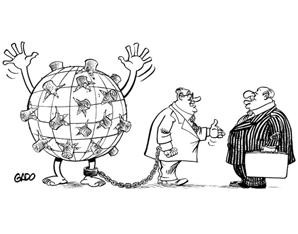
Scenario 1: "Markets First"
Most of the world adopts the values and expectations prevailing in today's industrialized countries. The wealth of nations and the optimal play of market forces dominate social and political agendas. Trust is placed in further globalization and liberalization to enhance corporate wealth, create new enterprises and livelihoods, and so help people and communities to afford to insure against - or pay to fix - social and environmental problems. Ethical investors, together with citizen and consumer groups, try to exercise growing corrective influence but are undermined by economic imperatives. The powers of state officials, planners and lawmakers to regulate society, economy and the environment continue to be overwhelmed by expanding demands. By 2032, many of the same questions that were being posed at the turn of the century remain unanswered.
Opinions differ as to where the world is heading. Depending on which indicators the observer chooses to focus upon, arguments can be made for either side. Many argue that the cases of breakdown already seen in some social, environmental and ecological systems portend even more fundamental and widespread collapses in the future. These same groups express particular concern that efforts have not been made to develop the institutions that will be needed to handle these predicaments. Others point out that we have been able to handle most of the crises we have faced and that there is no reason to assume we will not do likewise in the future. Most people stick to their daily routines, leaving the big questions to others. "Plus ça change, plus c'est la même chose" -the more things change, the more they stay the same.
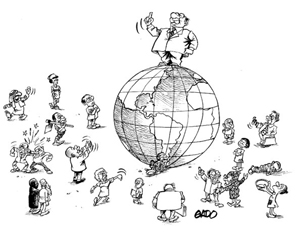
Scenario 2: " Policy First"
Decisive initiatives are taken by governments in an attempt to reach specific social and environmental goals. A coordinated pro-environment and anti-poverty drive balances the momentum for economic development at any cost. Environmental and social costs and gains are factored into policy measures, regulatory frameworks and planning processes. All these are reinforced by fiscal levers or incentives such as carbon taxes and tax breaks. International ‘soft law' treaties and binding instruments affecting environment and development are integrated into unified blueprints and their status in law is upgraded, though fresh provision is made for open consultation processes to allow for regional and local variants. In summary, the forces driving the world in unsustainable directions, while not necessarily defeated, appear to be on the way to being tamed. The actions that have been required to keep the world on track to meet the long-term goals have not always been popular and have often been expensive. Growing (although stabilizing) populations and improving lifestyles continue to intensify demands for water, food, forest resources and space.
Efforts to reduce emissions of greenhouse gases have required fairly high levels of taxation on most energy sources and certain industrial chemicals, as well as expensive shifts in agricultural practices. There is a question as to how much more can be accomplished with similar policies, even given fresh technological advances. There is also a question mark over how long businesses and the general public will carry on accepting such policies. Without fundamental changes in human behaviour and demands, the achievement of sustainability could well mean an ever more managed, bureaucratic, technocratic and ultimately dehumanized world.
Here we have a world reminiscent of the 1985 film ''Brazil''.


'Brazil' & 'Soylent Green': Two nightmarish worlds, one due to overwhelming bureaucracy, the other due to overpopulation and social rift.
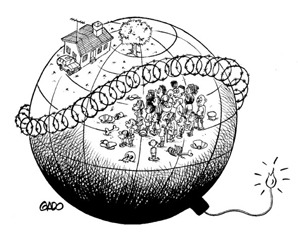
Scenario 3: "Security First"
This scenario assumes a world of striking disparities where inequality and conflict prevail. Socio-economic and environmental stresses give rise to waves of protest and counteraction. As such troubles become increasingly prevalent, the more powerful and wealthy groups focus on self-protection, creating enclaves akin to the present day ‘gated communities'. Such islands of advantage provide a degree of enhanced security and economic benefits for dependent communities in their immediate surroundings but they exclude the disadvantaged mass of outsiders. Welfare and regulatory services fall into disuse but market forces continue to operate outside the walls.
In an atmosphere of increasing social, environmental and economic tensions, violence is endemic. War and environmental degradation lead to massive movements of refugees in some regions. By 2032, an air of uneasy stability has begun to settle on this divided world. It is unclear, though, how long this truce can last. The forces for further breakdown are ever present. At the same time, dreams of a better way still beckon. Whereas many of the fears of the pessimists have come true, fresh opportunities for positive change have not ceased to appear. Outside the walls, small islands of calm exist and work is under way there to build links with others and with progressive elements within the fortresses, offering hope that someday, like the phoenix rising from its ashes, a better world for all might yet emerge.
Such a neo-medieval world is depicted in the 1973 film 'Soylent Green'.
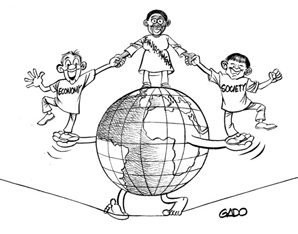
Scenario 4: "Sustainability First"
A new environment and development paradigm emerges in response to the challenge of sustainability, supported by new, more equitable values and institutions. A more visionary state of affairs prevails, where radical shifts in the way people interact with one another and with the world around them stimulate and support sustainable policy measures and accountable corporate behaviour. There is much fuller collaboration between governments, citizens and other stakeholder groups in decision-making on issues of close common concern. A consensus is reached on what needs to be done to satisfy basic needs and realize personal goals without beggaring others or spoiling the outlook for posterity.
The interlinked sets of changes that have occurred during the first three decades of the new millennium are clearly part of a broad societal transformation. Although no one would argue that sustainability has been achieved, there is a clear sense that the world is moving in the right direction and there is no turning back.
9 yeats after
In Greece, like in many other countries, 9 years after the diverse predictions of UNEP, most signs indicate that we are heading in the direction of the scenario putting emphasis on the 'Market', which is becoming increasingly dominant in the development of human societies. The forces of money overcome national borders, edify international and local institutional frameworks, promote their own aesthetic and architectural values, convert the protection of the environment into business.
The political representatives are increasingly unable to resist the economic interests and to impose effective regulations that are friendly for the people, the environment, and the future, thus weakening the possibility of the second, 'Policy' scenario.
At the same time, the Twin Towers after-effects (unforeseen in 2002), together with the rapid expansion of the rich and poor gap even in developed countries, indicate that the third, 'Security' scenario may not be too far from the world of the coming decades.
The fourth, 'Sustainability' scenario requires a wide and powerful emancipation from the new anti-enlightenment forces that drive humanity back to the distant past. Given the current balance of power, such prospect does not seem to have many chances, except perhaps if the advancing market totalitarianism is slowed down by unexpected events.
Nonlinear scenarios
The four UNEP scenarios assume a gradual, linear change starting from today. But nothing rules out non-linear options due to unexpected causes. Thus, an additional scenario could be an unprecedented ecological and social crisis, which quickly runs out of control. Such a crisis need not occur after an initial warning that would give sufficient time to respond. It could be unforeseen as a heart attack that has been developing for a long time without obvious symptoms, until it causes sudden disruption and collapse. Two such scenarios are presented in the films 'Planet of the Apes' (1968) and '12 Monkeys' (1995).


'Planet of the Apes' &'12 monkeys': Two versions of sudden destruction, one due to war, one due to plague.
The social context of architecture in the future
Architecture has always been the scene of social events. Therefore the changes on the current circumstances should certainly affect the ways we organize built space. As the tension between private and public is intensifying and the former is prevailing, the distribution of wealth goes back to an old fashion inequity. The post-war 'affluent society' and the 'welfare state' sink beneath the globalization tsunami that followed the earthquake of the collapse of Soviet counter-power.
Here is an interesting paradox: Despite the fact that today the world's per capita GDP is 3.5 times higher than 30 years ago (World Bank), we are constantly hearing about 'recession'. At the same time, a small percentage of the population is financially getting better and better, in defiance of the fanfare about 'crisis' and 'austerity' that are obviously referring to the rest.
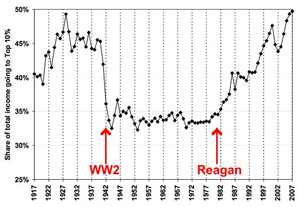
A diagram illustrating the current Croesus 'crisis':
The Top Decile Income Share in the United States, 1917-2007 ['Top Incomes in the Long Run of History'].
Similar upward trends during the neo-liberal period after 1980 are observed in other countries too, especially in the wealthiest 1% of the population.
Within a context of significant economic and social upheaval, and while the planet complains about human folly, it is reasonable to expect an impact on the status of the architect, on the subjects and manners of his work, on his education. How architecture will express our 'brave new world'? What kind of buildings will absorb investments and how we will decide on that? For example, will schools or apartment blocks lessen as usual architectural themes, while prisons and 5 star hotels (with green features of course) proliferate? Which forces and what criteria will shape urban areas? How useful architects will be in their current form? Is there a future for small practices? In a two-tier society, will there be two-tier architects too? Will diplomas be replaced by 'fast track' training certificates?
Such multiple questions are a vital issue for extensive and systematic scrutiny by the theorists of architecture, possibly as an architectural addendum to the GEO-3 scenarios. And of course, is a hot topic for all current and future colleagues. Unless we think that the next 30-40 years will be like the past 30-40.


Thanos N. Stasinopoulos
Dr. Architect Engineer, AAGradDipl.
7.1.2011
Related articles:
- Pills or diet? ( 31 August, 2011 )
- The fever of the naked emperor ( 15 November, 2010 )
- After the bubble gums ( 12 September, 2010 )
- Thanos Stasinopoulos .PIRAEUS TOWER 2010 ( 08 October, 2010 )
- Barriers, barriers everywhere ( 14 December, 2010 )
- Parks and submarines ( 21 February, 2011 )
- The oil barrel project ( 28 April, 2011 )
- “We are animals” ( 02 June, 2011 )
- On Winds and Waters ( 11 July, 2011 )
- The Titanic ( 07 October, 2012 )










